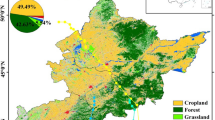Abstract
Some satellite-based indices are useful for fire susceptibility estimation in some regions. However, the obtained results are region-dependent to some extent. The aim of this study is to assess the effectiveness of two NDVI-derived indices: the relative greenness index (RGI) and the vegetation danger index (VDI) applied to the northern China. Thus, the Moderate Resolution Imaging Spectroradiometer sensor (MODIS) data MYD13Q1, which is the 16-days composite product, were used. The results indicated that the RGI values were higher than 70% during the before-fire period from spring up to autumn, whereas it have decreased sharply when fire happened and after a period time and also it was below normal level during a period of after-fire. The VDI values were negative when fire happened and after a short period and that of the before fire and after fire were positive. Thus, it can be concluded that the two MODIS-based NDVI-derived indices have a higher possibility for fire susceptibility estimation even though it needs to combine other fire-related parameters.
Access this chapter
Tax calculation will be finalised at checkout
Purchases are for personal use only
Preview
Unable to display preview. Download preview PDF.
Similar content being viewed by others

References
Telesca, L., Kanevski, M., Tonini, M., Pezzatti, G.B., Conedera, M.: Temporal patterns of fire sequences observed in Canton of Ticino (southern Switzerland). Natural Hazards and Earth System Sciences 10, 723–728 (2010)
Crutzen, P.J., Andreae, M.O.: Biomass Burning in the Tropics - Impact on Atmospheric Chemistry and Biogeochemical Cycles. Science 250, 1669–1678 (1990)
Kaskaoutis, D.G., Kharol, S.K., Sifakis, N., Nastos, P.T., Sharma, A.R., Badarinath, K.V.S., et al.: Satellite monitoring of the biomass-burning aerosols during the wildfires of August 2007 in Greece: Climate implications. Atmospheric Environment 45, 716–726 (2011)
Li, Z.Q.: Influence of absorbing aerosols on the inference of solar surface radiation budget and cloud absorption. Journal of Climate 11, 5–17 (1998)
Li, L.M., Song, W.G., Ma, J., Satoh, K.: Artificial neural network approach for modeling the impact of population density and weather parameters on forest fire risk. International Journal of Wildland Fire 18, 640–647 (2009)
Stow, D., Niphadkar, M., Kaiser, J.: MODIS-derived visible atmospherically resistant index for monitoring chaparral moisture content. International Journal of Remote Sensing 26, 3867–3873 (2005)
Chowdhury, E.H., Hassan, Q.K.: Use of remote sensing-derived variables in developing a forest fire danger forecasting system. Natural Hazards 67, 321–334 (2013)
Chuvieco, E., Cocero, D., Riano, D., Martin, P., Martinez-Vega, J., de la Riva, J., et al.: Combining NDVI and surface temperature for the estimation of live fuel moisture content in forest fire danger rating. Remote Sensing of Environment 92, 322–331 (2004)
Lopez, S., Gonzalez, F., Llop, R., Cuevas, J.M.: An Evaluation of the Utility of Noaa Avhrr Images for Monitoring Forest-Fire Risk in Spain. International Journal of Remote Sensing 12, 1841–1851 (1991)
GonzalezAlonso, F., Cuevas, J.M., Casanova, J.L., Calle, A., Illera, P.: A forest fire risk assessment using NOAA AVHRR images in the Valencia area, eastern Spain. International Journal of Remote Sensing 18, 2201–2207 (1997)
Illera, P., Fernandez, A., Delgado, J.A.: Temporal evolution of the NDVI as an indicator of forest fire danger. International Journal of Remote Sensing 17, 1093–1105 (1996)
Kaufman, Y.J., Ichoku, C., Giglio, L., Korontzi, S., Chu, D.A., Hao, W.M., et al.: Fire and smoke observed from the Earth Observing System MODIS instrument - products, validation, and operational use. International Journal of Remote Sensing 24, 1765–1781 (2003)
Telesca, L., Lasaponara, R.: Vegetational patterns in burned and unburned areas investigated by using the detrended fluctuation analysis. Physica a-Statistical Mechanics and its Applications 368, 531–535 (2006)
Veraverbeke, S., Gitas, I., Katagis, T., Polychronaki, A., Somers, B., Goossens, R.: Assessing post-fire vegetation recovery using red-near infrared vegetation indices: Accounting for background and vegetation variability. Isprs Journal of Photogrammetry and Remote Sensing 68, 28–39 (2012)
Leon, J.R.R., van Leeuwen, W.J.D., Casady, G.M.: Using MODIS-NDVI for the Modeling of Post-Wildfire Vegetation Response as a Function of Environmental Conditions and Pre-Fire Restoration Treatments. Remote Sensing 4, 598–621 (2012)
Prosper-Laget, V., Douguedroit, A., Guinot, J.P.: A satellite index of risk of forest fire occurrence in summer in the Mediterranean area. International Journal of Wildland Fire 8, 173–182 (1998)
Lasaponara, R.: Inter-comparison of AVHRR-based fire susceptibility indicators for the Mediterranean ecosystems of southern Italy. International Journal of Remote Sensing 26, 853–870 (2005)
Kogan, F.N.: Remote-Sensing of Weather Impacts on Vegetation in Nonhomogeneous Areas. International Journal of Remote Sensing 11, 1405–1419 (1990)
Burgan, R.E., Andrews, P.L., Bradshaw, S.L., Chase, C.H., Hartford, R.A., Latham, D.J.: Current status of the wildland fire assessment system (WFAS). Fire Management Notes 57, 14–17 (1997)
Lanorte, A., Danese, M., Lasaponara, R., Murgante, B.: Multiscale mapping of burn area and severity using multisensor satellite data and spatial autocorrelation analysis. International Journal of Applied Earth Observation and Geoinformation 20, 42–51 (2013)
Telesca, L., Lasaponara, R.: Pre and post fire behavioral trends revealed in satellite NDVI time series. Geophysical Research Letters 33(14) (2006)
Tuia, D., Ratle, F., Lasaponara, R., Telesca, L., Kanevski, M.: Scan statistics analysis of forest fire clusters, pp. 1689–1694 (2008)
Author information
Authors and Affiliations
Corresponding author
Editor information
Editors and Affiliations
Rights and permissions
Copyright information
© 2015 Springer International Publishing Switzerland
About this paper
Cite this paper
Li, X., Lanorte, A., Telesca, L., Song, W., Lasaponara, R. (2015). Assessment of MODIS-Based NDVI-Derived Index for Fire Susceptibility Estimation in Northern China. In: Gervasi, O., et al. Computational Science and Its Applications -- ICCSA 2015. ICCSA 2015. Lecture Notes in Computer Science(), vol 9158. Springer, Cham. https://doi.org/10.1007/978-3-319-21410-8_15
Download citation
DOI: https://doi.org/10.1007/978-3-319-21410-8_15
Published:
Publisher Name: Springer, Cham
Print ISBN: 978-3-319-21409-2
Online ISBN: 978-3-319-21410-8
eBook Packages: Computer ScienceComputer Science (R0)



